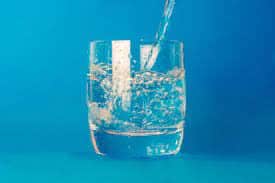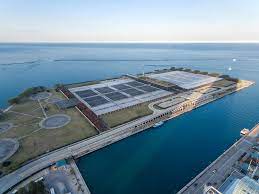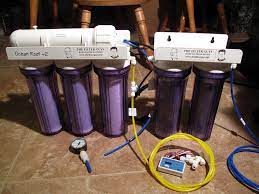WHAT IS WATER AND WHERE DOES TAP WATER COME FROM

Water is a transparent, tasteless, and odourless liquid that is essential for most forms of life on Earth. It is composed of two hydrogen atoms and one oxygen atom, giving it the chemical formula H2O. Water is the most abundant substance on Earth, covering about 71% of the planet’s surface. It is also a vital component of many biological and chemical processes, and is used for a wide range of purposes, such as drinking, washing, and manufacturing.

WHERE DOES WATER COME FROM
Untreated natural Water comes from a variety of sources, including precipitation, surface water, and groundwater. Rain, snow, and hail, falls from the atmosphere and provides a small but significant portion of the Earth’s water supply. However, surface water, such as rivers, lakes, and oceans, also contribute to the water supply greatly with oceans accounting for over 90% of all earths water supply https://www.usgs.gov/special-topics/water-science-school/science/how-much-water-there-earth#overview , as do underground sources of water known as groundwater hold a lot more fresh water than what you actually see on the surface .
WHAT IS SOFT WATER V HARD WATER
The difference between soft and hard water is the amount of minerals, such as calcium and magnesium, that are present in the water to begin with. Soft water areas have a low mineral content and this is due to the non-porous rocks that water passes through such as granite. In Scotland this is a very typical rock on our landscape and what Ben Nevis is made from, so it is no surprise that the general water quality is classed as soft. Hard water has a high mineral content and is often found in areas high in rocks such as limestone particularly, so as the rainwater falls onto such porous rocks such as limestone, the water passes through and picks up more salt based minerals such as calcium and magnesium. The impact of soft and hard water is found at the processing stage, as an example when we are window cleaning in Fife it is cost effective to remove the mineral content from water using a Deionized resin process but if this was a hard water area the resin would not last long at all before needing changed and thus, we would have to rely on a process of water filtration that has more stages and this would be reverse osmosis which you can find out more about here
WHERE DOES TAP WATER COME FROM
Converting natural water into tap water is a complex process that involves several stages of treatment and purification. The process is designed to remove impurities such as the minerals mentioned above and contaminants such as debris and waste from the water, to then make it safe for human consumption. This process typically involves several machines and pieces of equipment that work together to provide clean and safe water. The process of turning natural water into tap water typically begins with the collection of raw water from a natural source such as a river, lake, or underground aquifer. The raw water is then transported to a water treatment plant, where it undergoes several stages of treatment and purification.
The first stage of water treatment is called screening. This is the process of removing large objects such as sticks, leaves, and debris from the raw water. The water is passed through a series of screens that trap these large objects and prevent them from entering the treatment process. Once the water has been screened, it moves on to the next stage of treatment, which is called coagulation. During this stage, chemicals such as alum are added to the water. These chemicals cause impurities such as dirt and sediment to clump together and settle to the bottom of the treatment tank. The next stage of treatment is called sedimentation. During this stage, the water is allowed to sit in a large tank or basin. The impurities that have settled to the bottom of the tank are removed, leaving behind clean water.
The next stage of treatment is called filtration. During this stage, the water is passed through a series of filters that remove smaller impurities such as sand and dirt. The filters are typically made of sand, gravel, and carbon, and are designed to remove impurities down to a very small size. Once the water has been filtered, it moves on to the next stage of treatment, which is called disinfection. During this stage, chemicals such as chlorine are added to the water. These chemicals kill any remaining bacteria, viruses, and other microorganisms that may be present in the water. The final stage of water treatment is called fluoridation. During this stage, fluoride is added to the water to help prevent tooth decay. Fluoride is a naturally occurring mineral that has been shown to be effective in preventing tooth decay. The machines and equipment used in the water treatment process can vary depending on the size and complexity of the treatment plant.
WHAT IS IN TAP WATER
Tap water is another form of water but you can click the following link to find out more about the different types of water in more detail. Tap water contains a variety of chemicals and minerals, including water molecules, dissolved minerals, and various chemical additives such as chlorine and fluoride. The specific chemicals and minerals in tap water can vary depending on the source of the water and the treatment methods used to purify it. Common minerals found in tap water include calcium, magnesium, and potassium, while common chemical additives include chlorine and fluoride.

IS TAP WATER SAFE TO DRINK
Tap water is generally safe to drink in most developed countries. This is because it undergoes a rigorous treatment process to remove impurities and contaminants that could be harmful to human health. However, the safety of tap water can vary depending on where you live and the quality of the water treatment system in your area. In general, tap water is regulated by government agencies such as the Environmental Protection Agency (EPA) in the United States and the Drinking Water Inspectorate (DWI) in the United Kingdom. These agencies set standards for the maximum allowable levels of contaminants in tap water and monitor water treatment systems to ensure that these standards are met.
Despite these regulations, there are still some potential risks associated with tap water. For example, lead pipes and plumbing fixtures can leach lead into the water, which can be harmful to human health. In addition, some water treatment systems may not be effective in removing certain contaminants such as pesticides or pharmaceuticals. To ensure that your tap water is safe to drink, it is important to follow some basic precautions. First, you should always follow any boil water advisories that are issued by your local government. Boiling water can kill any bacteria or viruses that may be present in the water. Second, you should consider using a water filter to remove any impurities or contaminants that may be present in your tap water. There are several types of water filters available, including activated carbon filters and reverse osmosis filters. These filters can remove a wide range of contaminants, including chlorine, lead, and pesticides.
Finally, you should be aware of the potential risks associated with lead pipes and plumbing fixtures. If you live in an older home, you should have your water tested for lead. If high levels of lead are detected, you may need to replace your pipes and fixtures to ensure that your tap water is safe to drink. In conclusion, tap water is generally safe to drink in most developed countries. However, there are still some potential risks associated with tap water, including lead contamination and the presence of certain contaminants that may not be effectively removed by water treatment systems. To ensure that your tap water is safe to drink, it is important to follow basic precautions such as boiling water, using a water filter, and testing for lead contamination.
IS TAP WATER GOOD FOR YOU
Tap water is an excellent source of hydration and is generally considered to be good for you. It is free of calories, sugar, and artificial sweeteners, making it a healthier alternative to sugary drinks such as soda and juice. In addition, tap water contains important minerals such as calcium and magnesium, which are essential for maintaining healthy bones and teeth. Drinking tap water can also help to promote weight loss and improve digestion. Studies have shown that people who drink more water tend to consume fewer calories and are less likely to be overweight or obese. In addition, drinking water can help to keep the digestive system functioning properly, preventing constipation and other digestive problems. Despite these benefits, there are some potential risks associated with tap water. For example, tap water may contain contaminants such as lead, chlorine, and fluoride, which can be harmful to human health if consumed in large quantities. In addition, some people may be sensitive to the taste or odor of tap water, which can make it difficult to drink.
To ensure that your tap water is safe and healthy, it is important to follow some basic precautions. First, you should always drink water from a clean and well-maintained source, such as a municipal water system or a well that has been tested for contaminants. Second, you should consider using a water filter to remove any impurities or contaminants that may be present in your tap water. Finally, you should be aware of any potential risks associated with your tap water, such as lead contamination or high levels of fluoride. However, tap water is generally considered to be good for you and is an excellent source of hydration and basic minerals. It is free of calories, sugar, and artificial sweeteners, making it a healthier alternative to sugary drinks. However, there are some potential risks associated with tap water, including the presence of contaminants such as lead, chlorine, and fluoride. To ensure that your tap water is safe and healthy, it is important to follow basic precautions such as drinking from a clean and well-maintained source and using a water filter to remove any impurities or contaminants that may be present.
IS FLUORIDE IN TAP WATER
Fluoride is added to tap water as a public health measure to help prevent tooth decay and cavities. The addition of fluoride to tap water has been shown to be an effective way of reducing the incidence of tooth decay, particularly in children. When fluoride is ingested, it becomes incorporated into the structure of developing teeth, making them more resistant to decay. Fluoride can also help to remineralizer teeth that have already been damaged by acid erosion. The use of fluoride in tap water has been widely studied and is considered safe and effective way of improving dental health in the population.
Fluoride is a naturally occurring mineral that is commonly added to tap water and dental products such as toothpaste and mouthwash. Fluoride is added to tap water and dental products because it has been shown to help prevent tooth decay and cavities. When fluoride is ingested, it becomes incorporated into the structure of developing teeth, making them more resistant to decay. Fluoride can also help to remineralizer teeth that have already been damaged by acid erosion. While fluoride is considered to be safe and effective in preventing tooth decay, excessive fluoride exposure can lead to dental fluorosis, a condition that causes white spots to develop on the teeth.
In high doses Some studies have also suggested that fluoride exposure may be linked to other health problems, such as bone fractures and cancer, although the evidence for these associations is mixed. Despite these concerns, most public health organizations, including the World Health Organization and the American Dental Association, continue to support the use of fluoride in tap water as a safe and effective way of improving dental health in the population.
DOES BOILING WATER REMOVE FLUORIDE
Fluoride is a very stable ion and is not affected by boiling water. When water is boiled, the water evaporates, and the fluoride ions become more concentrated in the remaining water. This means that boiling water can increase the concentration of fluoride in the water, rather than reducing it. To remove fluoride from water, other methods such as reverse osmosis or activated alumina filtration are required.
IS THERE CHLORINE IN TAP WATER
Chlorine is added to tap water as a disinfectant to kill harmful bacteria and viruses that may be present in the water. Chlorine is a powerful oxidizing agent that can destroy a wide range of pathogens, including bacteria, viruses, and protozoa. By adding chlorine to tap water, water treatment facilities can help to ensure that the water is safe to drink and free from harmful pathogens. While chlorine can have a strong odor and taste, it is generally considered to be safe to drink in the concentrations typically used in tap water.
HOW MUCH CHLORINE IS IN TAP WATER
The amount of chlorine in tap water can vary depending on a number of factors, including the source of the water, the treatment process used, and the location of the water supply. In general, the concentration of chlorine in tap water is regulated by national or regional standards to ensure that the water is safe to drink. The concentration of chlorine in tap water is typically measured in parts per million (ppm). In the UK, the Drinking Water Inspectorate recommends that the concentration of chlorine in tap water should be between 0.5 and 5 ppm. The hardness of the water does not have a significant effect on the concentration of chlorine in tap water.
WHAT IS LIMESCALE AND WHY IS IT IN TAP WATER
Limescale is primarily composed of calcium carbonate, which is a naturally occurring mineral found in many types of rock, including limestone, marble, and chalk. When hard water is heated or evaporates, the minerals in the water can form a hard, chalky deposit called limescale. In addition to calcium carbonate, limescale can also contain other minerals and impurities that are present in the water, such as magnesium, silica, and iron. While limescale itself is not harmful to human health, it can cause problems in appliances such as kettles, washing machines, and dishwashers by reducing their efficiency and lifespan.
Limescale is not added to water. Limescale is a naturally occurring deposit that can build up in water pipes and appliances, particularly in areas with hard water. Hard water is water that contains high levels of dissolved minerals, such as calcium and magnesium. When hard water is heated or evaporates, the minerals can form a hard, chalky deposit called limescale. While limescale itself is not harmful to human health, it can cause problems in appliances such as kettles, washing machines, and dishwashers by reducing their efficiency and lifespan. It can also cause aesthetic problems, such as leaving white marks on glassware and shower screens.
WHY ARE ALL MINERALS NOT REMOVED FROM TAP WATER
Minerals such as calcium, magnesium, and potassium are naturally occurring substances that can be found in soil and rocks. When rainwater falls to the ground, it can pick up these minerals as it passes through the soil and rocks. This water then becomes part of the groundwater system, which supplies water to wells and other sources of drinking water. While these minerals are generally considered safe for human consumption, they can cause problems in appliances and plumbing by forming limescale, particularly in areas with hard water. Some people also prefer to remove these minerals from their drinking water for aesthetic or health reasons, and there are various methods of doing so, such as using a water softener or a reverse osmosis system.
Calcium is not typically removed from tap water because it is an essential mineral that is important for maintaining healthy bones and teeth. Calcium is also important for other bodily functions, such as muscle and nerve function, and it is present in many foods and supplements. While high levels of calcium in water can cause problems such as limescale, the levels of calcium found in most tap water are generally considered safe for human consumption. Some people may choose to remove calcium from their drinking water for aesthetic reasons, such as to reduce the formation of limescale, but this is not typically necessary for health reasons.





